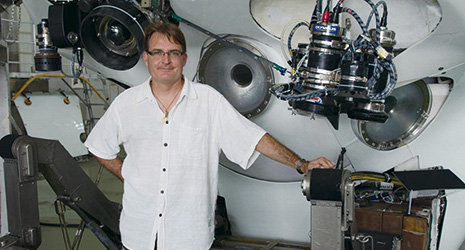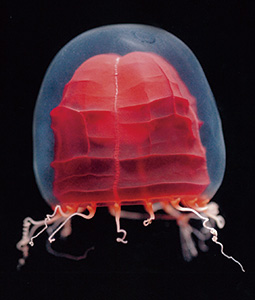Home > Highlighting JAPAN > Highlighting Japan April 2018 > My Way
Highlighting JAPAN


Jellyfish and Haiku
An Australian marine researcher is making discoveries in the waters off Japan while breathing new life into the world of haiku.
Australian Dhugal J. Lindsay, PhD belongs to the Research and Development Center for Submarine Resources under the Japan Agency for Marine-Earth Science and Technology (JAMSTEC), where he studies marine organisms and works on equipment development.
Born and raised in Rockhampton near the Great Barrier Reef, a UNESCO World Heritage site, Lindsay says he always felt a connection with Japan because many Japanese tourists visited his hometown and a Japanese exchange student attended his senior high school. Lindsay went to the University of Queensland (UQ), where he majored in science. However, he chose to spend a year abroad studying the Japanese language at a Japanese university.
Lindsay recalls his surprise that Japanese universities that offered a course on oceanography all had their own oceanographic research vessel. It occurred to him that a Japanese university would enable him to study marine organisms, his passion, in depth.
After graduating from UQ in 1992, Lindsay entered the graduate school at the University of Tokyo, studying marine organisms, and earned his doctorate. He joined JAMSTEC in 1997 and began deep-sea investigations around the world.
Jellyfish became Lindsay’s specialty, growing fond of them having wondered about their great diversity all over the world. He spends two to three months at sea each year, studying jellyfish sometimes by diving into the ocean in a manned research submersible.
The ecology of jellyfish is very mysterious and many things remain unclear. Some species of jellyfish live at the bottom of the ocean, while others float in the water. Tiny species can measure about 5 millimeters, but large ones can be up to 40 meters in length. They are not limited to sexual reproduction. Some species can breed independently; others proliferate by changing their form to anemone-like polyps on the ocean floor. Jellyfish occur under all kinds of environmental conditions and are highly diverse. Counting only species that float in the water, there are over 1,000 species. Lindsay is discovering new species one after another in his research.
The discoverer of any new species has the right to give it an official scientific name and, if they understand Japanese, a Japanese name. Lindsay has discovered many jellyfish, and gave Japanese names to the giant medusa Stygiomedusa, “dai-o kurage” (Emperor jellyfish), and to Pandea rubra, a species with a red lantern-like form, “aka chochin kurage” (red paper lantern jellyfish).
Lindsay is also a master haiku poet. His Japanese vocabulary may be larger than that of an average Japanese person, and his haiku skills are so distinguished that a major newspaper appointed him to select contributions to its haiku page from those submitted from overseas.
Recently, people abroad have begun composing haiku in many languages. However, Lindsay writes his haiku in Japanese. It started with his homestay during university. He lived with a family where one member happened to be the haiku poet Yoko Sugawa.
Lindsay says that “saijiki,” a catalog of the season-specific words necessary for composing haiku, surprises him with the many words associated with nature in Japan. Citing the beautiful word hikobae, used to describe little buds that grow from a tree stump, he points out that there is even a Japanese verb, hikobayuru, that stems from it. Calling those words amazing, he notes the depth of the Japanese language.
Lindsay is scheduled to give a lecture at a national contest for haiku about the ocean to be held in Fukushima Prefecture in July 2018. He plans to discuss marine organisms, citing examples of gaps between their real ecology and people’s understanding of them.
Lindsay notes that relatively few haiku in Japan are written about marine organisms, and says he wants people in Japan to learn more about marine organisms and to compose haiku about them because Japan is surrounded by the ocean. Lindsay adds that it would be wonderful if he could eventually compile an “umi-no saijiki,” a catalog of season-specific words about the ocean used for composing haiku.
As a matter of course, marine organisms appear in many of his haiku.
Umihebi no
nagaki hitoiki
tsuyu ni iru
the sea snake
takes a long, long breath
rainy season starts
Sea snakes, the lungs of which occupy 80% of their body length, take extremely long and loud breaths. This haiku could only have been composed by a marine biologist.
Haiku are short poems composed by confronting the beauty or mystery of nature. Lindsay is working to discover the depths of jellyfish and haiku through exploring the ocean, the object of his affections.
© 2009 Cabinet Office, Government of Japan







